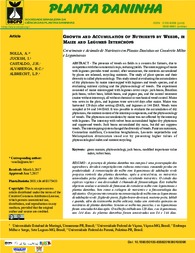Growth and accumulation of nutrients by weeds, in maize and legumes intercrops.
Growth and accumulation of nutrients by weeds, in maize and legumes intercrops.
Author(s): NOLLA, A.; JUCKSH, I.; CASTALDO, J. H.; ALVARENGA, R. C.; ALBRECHT, L. P.
Summary: The presence of weeds on fields is a concern for farmers, due to competition with the commercial crops, reducing yields. The intercropping of maize with legumes provides weed control; after senescence, the nutrients accumulated by plants are released, recycling nutrients. The study of plant species and their diversity is called phytosociology. This study aimed at evaluating the accumulation of dry phytomass by maize intercropped with legumes and weeds species, and at evaluating nutrient cycling and the phytosociology of weeds. The experiment consisted of maize intercropped with legumes cover crops: jack-beans, Brazilian jack-beans, velvet bean, lablab-beans, and pigeon pea, and the control treatment (maize without intercrop), all without chemical or mechanical weed control. Maize was sown in the plots, and legumes were sown 64 days after maize. Maize was harvested 120 days after sowing (DAS), and legumes at 144 DAS. Weeds were sampled at 84 and 144 DAS. It was possible to evaluate the accumulation of dry phytomass, the nutrient content of the intercrop components, and the phytosociology of weeds. The phytomass accumulation by maize was not affected by the intercrop with legumes. The intercrop with velvet bean accumulated higher dry phytomass and suppressed weeds. Jack beans accumulated dry mass, but did not suppress weeds. The intercropping system changed the diversity of weeds. Panicum maximum, Commelina nudiflora, Commelina benghalensis, Leonotis nepetaefolia and Melampodium divaricatum stood out by presenting higher values of phytosociological index and nutrient recycling.
Publication year: 2018
Types of publication: Journal article
Unit: Embrapa Maize & Sorghum
Observation
Some of Embrapa's publications are published as ePub files. To read them, use or download one of the following free software options to your computer or mobile device. Android: Google Play Books; IOS: iBooks; Windows and Linux: Calibre.
Access other publications
Access the Agricultural Research Database (BDPA) to consult Embrapa's full library collection and records.
Visit Embrapa Bookstore to purchase books and other publications sold by Embrapa.

